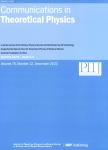Deep learning neural networks for the third-order nonlinear Schrodinger equation: bright solitons, breathers, and rogue waves
作者机构:Key Laboratory of Mathematics MechanizationAcademy of Mathematics and Systems ScienceChinese Academy of SciencesBeijing 100190China School of Mathematical SciencesUniversity of Chinese Academy of SciencesBeijing 100049China
出 版 物:《Communications in Theoretical Physics》 (理论物理通讯(英文版))
年 卷 期:2021年第73卷第10期
页 面:55-63页
核心收录:
学科分类:12[管理学] 1201[管理学-管理科学与工程(可授管理学、工学学位)] 07[理学] 081104[工学-模式识别与智能系统] 08[工学] 070104[理学-应用数学] 0835[工学-软件工程] 0704[理学-天文学] 0701[理学-数学] 0811[工学-控制科学与工程] 0702[理学-物理学] 0812[工学-计算机科学与技术(可授工学、理学学位)]
基 金:supported by the National Natural Science Foundation of China(Nos.11925108 and 11731014)
主 题:third-order nonlinear Schrodinger equation deep learning data-driven solitons data-driven parameter discovery
摘 要:The dimensionless third-order nonlinear Schrodinger equation(alias the Hirota equation) is investigated via deep leaning neural networks. In this paper, we use the physics-informed neural networks(PINNs) deep learning method to explore the data-driven solutions(e.g. bright soliton,breather, and rogue waves) of the Hirota equation when the two types of the unperturbated and perturbated(a 2% noise) training data are considered. Moreover, we use the PINNs deep learning to study the data-driven discovery of parameters appearing in the Hirota equation with the aid of bright solitons.



